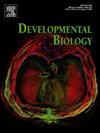Opposing effects between retinoic acid and Fibroblast growth factor in patterning the common crus and semicircular canals of the inner ear
IF 2.1
3区 生物学
Q2 DEVELOPMENTAL BIOLOGY
引用次数: 0
Abstract
The three orthogonally arranged semicircular canals and their sensory organs, cristae, of the inner ear are responsible for detecting angular head movements. A main functional component of this vestibular apparatus is the evolutionarily conserved unit of the anterior and posterior canals joined by a central stalk, the common crus. A resorption process (removal of epithelial cells) carves out these three connecting structures from an epithelial outpocket of the developing otic vesicle known as the vertical canal pouch. While molecules such as Fibroblast growth factors (FGF) and Bone morphogenetic proteins (BMP) emanating from the prospective sensory cristae and the rim of the canal pouch, counteract with the resorption process to form the canals, it is not known if there is an independent mechanism that mediates common crus formation. Here, we show that genes encoding retinoic acid (RA) synthesizing enzymes, Aldh1a2 and Aldh1a3, are expressed in the presumptive common crus region of the canal pouch. Blocking endogenous RA activity abolishes common crus formation. Endogenous RA may mediate common crus formation by limiting proliferation of the peri-otic mesenchyme at the prospective common crus region and thus counteracting the resorption process. Additionally, RA and FGF antagonize each other in patterning the common crus and canals, respectively. Ectopic FGF2 downregulates Aldh1a2 expression in the common crus, whereas Bmp2, required for canal formation, may be an intermediate which is co-regulated by RA and FGF.

维甲酸和成纤维细胞生长因子在内耳普通小腿和半规管形成中的相反作用。
内耳的三个垂直排列的半规管及其感觉器官嵴负责探测头部的角度运动。这个前庭器官的一个主要功能组成部分是进化上保守的前后椎管单位,由一个中央柄连接,即小腿。吸收过程(上皮细胞的移除)从发育中的耳小泡的上皮外袋(称为垂直管袋)中雕刻出这三个连接结构。虽然纤维母细胞生长因子(FGF)和骨形态发生蛋白(BMP)等分子来自前瞻性感觉嵴和管袋边缘,抵消吸收过程形成管,但尚不清楚是否有一个独立的机制介导共同小腿的形成。在这里,我们发现编码维甲酸(RA)合成酶的基因,Aldh1a2和Aldh1a3,在假定的管袋的共同小腿区域表达。阻断内源性RA活性可消除膝关节形成。内源性RA可能通过限制髋部周围间质在预期髋部区域的增殖,从而抵消吸收过程,从而介导髋部形成。此外,RA和FGF在共同小腿和管的图案中相互拮抗。异位FGF2下调了普通小腿中Aldh1a2的表达,而Bmp2可能是RA和FGF共同调节的中间体,而Bmp2是管道形成所必需的。
本文章由计算机程序翻译,如有差异,请以英文原文为准。
求助全文
约1分钟内获得全文
求助全文
来源期刊

Developmental biology
生物-发育生物学
CiteScore
5.30
自引率
3.70%
发文量
182
审稿时长
1.5 months
期刊介绍:
Developmental Biology (DB) publishes original research on mechanisms of development, differentiation, and growth in animals and plants at the molecular, cellular, genetic and evolutionary levels. Areas of particular emphasis include transcriptional control mechanisms, embryonic patterning, cell-cell interactions, growth factors and signal transduction, and regulatory hierarchies in developing plants and animals.
 求助内容:
求助内容: 应助结果提醒方式:
应助结果提醒方式:


